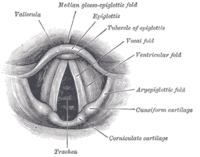
Photo from wikipedia
Populations living at high altitudes exhibit distinct cardiovascular and ventilatory responses to hypoxia, which may result from exposure to the selective pressure of chronic hypoxia throughout hundreds of generations at… Click to show full abstract
Populations living at high altitudes exhibit distinct cardiovascular and ventilatory responses to hypoxia, which may result from exposure to the selective pressure of chronic hypoxia throughout hundreds of generations at high altitude. Compared to Andean highlanders and some acclimatized lowlanders, many Tibetans show an increased hypoxic ventilatory response (HVR) and lower hemoglobin concentration ([Hb]). While the effects of menopause on [Hb] have been well studied, its effects on HVR and heart rate responses to hypoxia (HHRR) in Tibetan women residing at high altitude have not been elucidated. We hypothesized that hypoxic ventilatory and heart rate responses to hypoxia decrease with menopausal status in Tibetan women, suggesting a change of adaptation during post-reproductive years in women. We measured minute ventilation (VI) and heart rate (HR) during room air and acute hypoxia in 376 Tibetan women (age range 46-86 years old) living in in Mustang, Nepal (>11,482ft / 3,500m) and compared responses between pre- and post-menopausal groups (mean ± SEM). Using a rebreathing system, we induced hypoxia to produce events of at least 10% desaturation (from 91 ± 0.2% to 78 ± 0.2%), expressed HVR and HRR as -ΔVI / ΔSpO2 and -ΔHR / ΔSpO2, respectively, and tested for associations between HVR and HHRR with age and [Hb]. HVR, HHRR, and [Hb] associated negatively with age in the post- but not pre-menopausal group. During hypoxia, post-menopausal women had lower VI (14.2 ± 0.2 L/min) and HR (80 ± 1 BPM) when compared (p<0.01) to pre-menopausal women (16.9 ± 0.4 L/min for VI and 85 ± 1 BPM for HR). VI was also lower in room air conditions (p<0.01) for post-menopausal (11.5 ± 0.1 L/min) versus pre-menopausal women (12.6 ± 0.2 L/min). HVR and HHRR was lower in post- (0.21 ± 0.01 L/%O2 and 0.65 ± 0.02 BPM/%O2 respectively) versus pre-menopausal women (HVR: 0.34 ± 0.03 L/%O2 and HHRR: 0.92 ± 0.05 BPM/%O2). Pre-menopausal women also exhibited negative correlations with HVR and HHRR with increasing [Hb]; however, these correlations were not significant in the post-menopausal group. A non-blunted HVR is a hallmark of adaptation in Tibetans, and physiological changes observed in Tibetan women during later life stages may result in a loss of such traits. These data suggest a hypothesis of menopause-related loss, or change, of adaptation to high-altitude hypoxia among middle-aged to elderly Tibetan women. Supported by NSF award 1831530 to CMB and NIH 1R01HL145470 to TSS. This is the full abstract presented at the American Physiology Summit 2023 meeting and is only available in HTML format. There are no additional versions or additional content available for this abstract. Physiology was not involved in the peer review process.
Journal Title: Physiology
Year Published: 2023
Link to full text (if available)
Share on Social Media: Sign Up to like & get
recommendations!